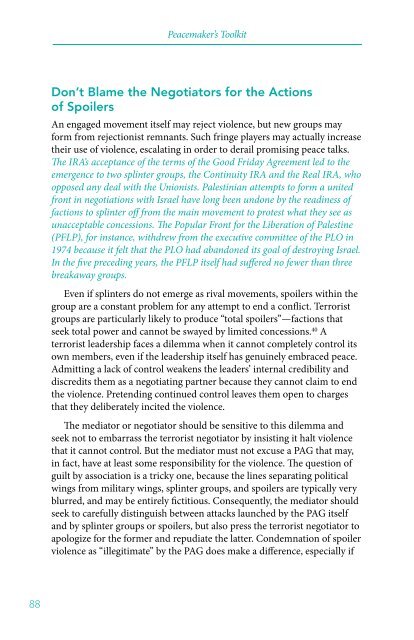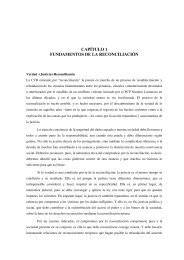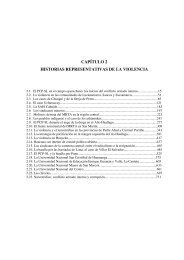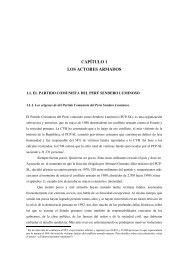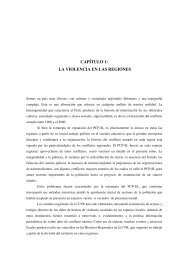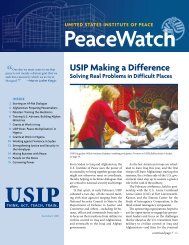Talking to Groups that Use Terror.pdf - United States Institute of Peace
Talking to Groups that Use Terror.pdf - United States Institute of Peace
Talking to Groups that Use Terror.pdf - United States Institute of Peace
Create successful ePaper yourself
Turn your PDF publications into a flip-book with our unique Google optimized e-Paper software.
<strong>Peace</strong>maker’s ToolkitDon’t Blame the Negotia<strong>to</strong>rs for the Actions<strong>of</strong> SpoilersAn engaged movement itself may reject violence, but new groups mayform from rejectionist remnants. Such fringe players may actually increasetheir use <strong>of</strong> violence, escalating in order <strong>to</strong> derail promising peace talks.The IRA’s acceptance <strong>of</strong> the terms <strong>of</strong> the Good Friday Agreement led <strong>to</strong> theemergence <strong>to</strong> two splinter groups, the Continuity IRA and the Real IRA, whoopposed any deal with the Unionists. Palestinian attempts <strong>to</strong> form a unitedfront in negotiations with Israel have long been undone by the readiness <strong>of</strong>factions <strong>to</strong> splinter <strong>of</strong>f from the main movement <strong>to</strong> protest what they see asunacceptable concessions. The Popular Front for the Liberation <strong>of</strong> Palestine(PFLP), for instance, withdrew from the executive committee <strong>of</strong> the PLO in1974 because it felt <strong>that</strong> the PLO had abandoned its goal <strong>of</strong> destroying Israel.In the five preceding years, the PFLP itself had suffered no fewer than threebreakaway groups.Even if splinters do not emerge as rival movements, spoilers within thegroup are a constant problem for any attempt <strong>to</strong> end a conflict. <strong>Terror</strong>istgroups are particularly likely <strong>to</strong> produce “<strong>to</strong>tal spoilers”—factions <strong>that</strong>seek <strong>to</strong>tal power and cannot be swayed by limited concessions. 40 Aterrorist leadership faces a dilemma when it cannot completely control itsown members, even if the leadership itself has genuinely embraced peace.Admitting a lack <strong>of</strong> control weakens the leaders’ internal credibility anddiscredits them as a negotiating partner because they cannot claim <strong>to</strong> endthe violence. Pretending continued control leaves them open <strong>to</strong> charges<strong>that</strong> they deliberately incited the violence.The media<strong>to</strong>r or negotia<strong>to</strong>r should be sensitive <strong>to</strong> this dilemma andseek not <strong>to</strong> embarrass the terrorist negotia<strong>to</strong>r by insisting it halt violence<strong>that</strong> it cannot control. But the media<strong>to</strong>r must not excuse a PAG <strong>that</strong> may,in fact, have at least some responsibility for the violence. The question <strong>of</strong>guilt by association is a tricky one, because the lines separating politicalwings from military wings, splinter groups, and spoilers are typically veryblurred, and may be entirely fictitious. Consequently, the media<strong>to</strong>r shouldseek <strong>to</strong> carefully distinguish between attacks launched by the PAG itselfand by splinter groups or spoilers, but also press the terrorist negotia<strong>to</strong>r <strong>to</strong>apologize for the former and repudiate the latter. Condemnation <strong>of</strong> spoilerviolence as “illegitimate” by the PAG does make a difference, especially if88


